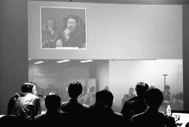 Beyond McLuhan
Beyond McLuhanSUEHIRO Nobuyuki
Monday Night Seminar in ICC
January 13, 20, February 3
ICC Gallery D
Through the birth and growth of the Internet, Marshall MCLUHAN's theories of "electric/electronic media becoming extensions of the human central nervous system and expanded to encompass the globe" have gained-across these 30 years-a practical meaning which has come to replace his somewhat optimistic dreams of a "Global Village." The Internet, particularly the hyperlinked nature of the World Wide Web, characteristic for its emancipation from time and directional constraints, offers a completely different phase from existing media. Considered in terms of MCLUHAN's adage "the medium is the message," the medium in its expansion has announced the arrival of a new message. Through reconsidering the context of MCLUHAN's theoretical oeuvre against the present, we stand to gain new insights into the composition of media literacy in a global information network environment, inquiries into methodologies of knowledge, and especially the potential for extracting issues of barriers to communication and their solutions.
After Marshall MCLUHAN's death, in order to continue his research, in 1983 the University of Toronto's Faculty of Information Studies established the McLuhan Program in Culture and Technology. With multidisciplinary contributing researchers, unbridled by the strictures of academism, the program investigates the psychological and social influences of communication technologies. Its Monday Night Seminars, initiated by MCLUHAN himself in the 1960s, are today free events open to the public, beginning at 19:30 each week.
This ICC Open Research Sessions-McLuhan Program Teleconferences-utilized an ISDN teleconference system to contribute to these Toronto "Monday Night Seminars." Three sessions were held between Toronto and Tokyo, with Paris also joining on the first session. The themes of these events were: "Connected Intelligence and Culture," "Connected Intelligence and Business," and "A Linguistic Revolution Born from Computer Society."
Connected Intelligence
The director of the McLuhan Program, Toronto University Professor Derrick DE KERCKHOVE has developed MCLUHAN's theories to propose his own concept, "connected intelligence." "In a present day, in which the Internet has been popularized throughout the world, human intelligence is not limited to the functions of the individual human brain, but rather formulates into the 'connected intelligence' of each individual's intellect, towards a new level of intelligence." That is, "A complex of multiple intelligences grappled at the same time, and functioning as a high-level communication system." Moreover, Professor DE KERCKHOVE considers that "each individual intellect is bound at a high dimension, making problem resolution possible." Connected Intelligence may at once be considered similar to the oriental group mind, however, group mind is, for example, passive in creative observation of disparate cultures from other times and places, and in its background exists tacit understandings of systemization and commonality. Connected Intelligence, on the other hand, might be considered a technology which is logical and pragmatic, available and effective for specified business and other objectives. Yet, we still need a new sympathetic intelligence device for dealing with the problems of art, religion, politics, the environment and others where tacit knowledge may be more essential than elucidation.
One topic which became the basis for discussion throughout the course of the sessions was the computer societies' alphabetical preference, and how this influences its preference for a logicality based on abstraction devoid of any ambiguity, and issues of machinic information-processing capabilities. However, considering the structure of human recognition and understanding, or the perspective of lucid knowledge becoming tacit, it is clear that the Chinese characters and other ideographs present issues which cannot be easily discarded. A certain preference for effective communication will, to some extent, certainly beckon towards a one-dimensionality of global language, but we must also recognize the cost of its result-an increasingly uniform world culture, and the discarding of our indigenous cultural legacies. Even seen from the perspective of Connected Intelligence, cultural diversity is an indispensable condition.
Teleconferencing as a Medium
Teleconferencing is a medium and a new message. Teleconferencing is also a place for producing Connected Intelligence. And yet the teleconferencing systems of the present are, in spite of today's information transmission systems and computer technologies' rapid advance, incapable of creating a structure which can invigorate these new systems. Important issues now and for the future include making access to teleconferencing technology-equipped facilities easier, making a well-considered, more transparent system operation technologies more suited to allowing those using the system being able to concentrate on the conference in progress.
The next issue is that we must design the conference space as an informationally commonspace, especially when dealing with remote locations with time differences that are connected through a common screen interface. We must design not only the many physical aspects of the space, including the lighting, but also the placement of the contributors, their size as represented on the screen, screen resolution and other factors. Among these, the contributors' distance from the screen (and camera), considering sense of distance and "eye contact," can carry meanings larger than language in teleconferencing communication. As Edward Twitchell HALL writes in The Silent Language, the use of space carries a language all its own. HALL's "proximics" offers an introduction to the problematics of interfacing actual and video spaces like the teleconferencing system, through which we might find an effective addition to the communication channels available to us.
Also concerning the proceedings of the conference, it would be desirable to maintain programs for optimizing objectives-designs to effect not only verbal interpretation but also non-verbal tacit communications. In short, the construction of an adaptable system based on the complex sensations of teleconferencing.
SUEHIRO Nobuyuki
Born in 1949. Researcher of information design. Visiting Lecturer at Musashino Art University and Tama Art University, Tokyo.
